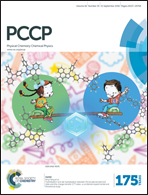Tunable thermal transport and mechanical properties of graphyne heterojunctions†
Abstract
By employing molecular dynamics simulations, a family of graphyne heterojunctions (GYHJs) made by two different graphynes (GYs) have been designed and prepared. The dependence of tunable properties of GYHJs, such as thermal conductivity, mechanical properties, interfacial thermal resistance and rectification, on the composition and type of GYHJs is determined. Upon changing the composition of a GYHJ, one can keep a constant value of its fracture strength (and/or Young's modulus), while tuning its thermal conductivity. The thermal conductivities of GYHJs in the zigzag direction are larger than those in the armchair direction, indicating GYHJs are anisotropic. By decreasing the percentage of γ-GY, the thermal conductivities of GYHJs γ-GY/6,6,12-GY/γ-GY and γ-GY/14-GY/γ-GY decrease linearly in the armchair direction, whereas they undergo three stages (first decrease, then keep a constant value, and finally increase) in the zigzag direction. Regarding the mechanical response, by increasing the percentage of the graphyne in the GYHJ which possesses smaller Young's modulus, the Young's modulus of the GYHJ decreases. These findings would provide significant insights into the potential applications of graphyne-family materials in nanodevices.


 Please wait while we load your content...
Please wait while we load your content...